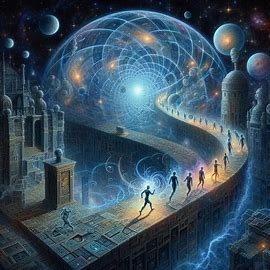Lessons from a Fountain: The Unique Insights of Life's Learners
In a serene moment by a sparkling fountain, a merchant, an old man, and a little girl gathered, each discovering a unique lesson from the waters before them. The fountain, adorned with an inscription urging, "Learn from me," became a silent teacher, imparting wisdom that resonated with each observer's perspective and capacity to understand.
The merchant, gazing
into the fountain's clear waters, saw a reflection of his entrepreneurial
journey. He mused how the fountain's modest beginning as a mere trickle
paralleled the humble starts of successful enterprises. Just as the trickle
gathered strength, merging with streams and brooks to become a mighty river, so
too could small, diligent efforts in business grow into grand successes. His
takeaway was clear: start small, work hard, and allow your endeavors to grow
organically and steadily, gathering momentum over time until they reach their
full potential.
For the old man, the
fountain represented silent service. He observed how the water flowed
ceaselessly, nourishing and refreshing all who came near, without fanfare or
expectation of reward. To him, this was a powerful lesson in humility and
altruism. He saw the fountain as a model for living a life of quiet, unwavering
service to others, offering help and kindness indiscriminately to both friends
and strangers. The fountain's silent, generous giving inspired him to embrace a
similar approach in his interactions with the world.
The little girl, with her innocent eyes, saw purity in the fountain's crystal-clear waters. She noted how animals instinctively avoided muddy water, seeking out only what was clean and pure. This observation led her to a simple yet profound conclusion: like the animals' quest for pure water, humans too should strive for purity in their lives. She believed that living a life free of corruption and filled with virtue was as essential as seeking out clean water to drink. The fountain's purity became a metaphor for living a chaste and morally upright life.
Each individual drew
from the same fountain a different lesson, reflecting their unique perspectives
and stages in life. The merchant's insight into growth and perseverance, the
old man's embrace of silent service, and the little girl's appreciation for purity
highlight the diverse ways in which we can interpret and learn from the same
source.
These varied
interpretations underscore a fundamental truth: everyone learns according to
their own aptitude and capacity. Life, much like the fountain, offers its
lessons to all, but it is our personal experiences, aspirations, and
understandings that shape what we take away from these teachings.
In this vast school of
life, no day should pass without learning something new. As J.P. Vaswani
beautifully encapsulates in his collection "101 Stories for You and
Me," a day without new knowledge or growth is indeed a lost day. The
fountain's silent guidance reminds us that wisdom is all around us, ready to be
absorbed in countless forms, suited to our individual journeys and capacities
to learn.
Reimagining Consciousness: From Cartesian Certainty to Dennett's
User-Illusion
The Cartesian notion of consciousness, articulated by René Descartes, has been a cornerstone of modern Western philosophy. Descartes famously declared that consciousness, encapsulated in the phrase "Cogito, ergo sum" ("I think, therefore I am"), is the one undeniable fact of existence. His dualistic framework posited a clear division between mind and body, setting the stage for centuries of debate about the nature of consciousness and its relationship to the physical world.
Modern scientific
advancements, particularly in physics, have further challenged Cartesian
dualism. The development of unified field theories suggests a more integrated
understanding of existence, where consciousness is not a separate entity but a
continuous thread woven through mind-body, space-time, and energy-matter. These
theories propose that the observer and the observed are not distinct, but
rather part of an indivisible whole.
In stark contrast to
Descartes, philosopher Daniel Dennett offers a radically different perspective
on consciousness. Dennett rejects the idea of a central, immaterial
consciousness and instead proposes a purely materialistic model grounded in
physical brain processes. His approach, known as heterophenomenology, relies
exclusively on scientific methods to study consciousness. Dennett argues
against a single, central point of conscious experience, positing instead what
he calls the "multiple drafts" model. In this model, consciousness
emerges from the dynamic interplay of numerous cognitive and physical processes
within the brain.
Dennett likens the mind to a computer, with consciousness acting as the user interface. Just as a computer's interface presents a simplified view of complex underlying software, human consciousness provides a user-friendly version of the intricate workings of the brain. This comparison extends to all states of awareness and emotions, which Dennett sees as products of physical processes encoded into memory. The brain's neurons engage in a kind of competition, with the "winning" neurons shaping our perceptions and actions. What we experience as conscious thought is merely the outcome of these neuronal battles, a narrative crafted by the dominant neurons among countless possibilities.
Central to Dennett's
theory is the concept of "user-illusion." Just as a computer's
desktop interface conceals the complexity of its internal operations, our
conscious experience simplifies the complex reality of brain functions. This
illusion allows us to navigate the world effectively, but it does not provide
an accurate or authoritative account of reality. According to Dennett, what we
perceive as our conscious experience is just a convenient simplification of the
underlying processes.
Dennett’s view of
consciousness as an illusion aligns with his broader commitment to Darwinian
evolution. He argues that human existence and behavior can be fully explained
by the principles of natural selection. From this perspective, there is no need
for a personal God, an intelligent designer, or an immaterial soul. Instead,
Dennett sees the diversity of life as a product of countless random mutations
and adaptations over time. This "Tree of Life" reflects the
magnificence of creation, not through intentional design, but through the
unintended and natural processes that shaped all living beings.
In summary, Dennett's
philosophy represents a significant departure from Cartesian dualism. He shifts
the focus from a central, immaterial consciousness to a distributed, physical
model grounded in brain activity. His metaphor of consciousness as a computer's
user interface encapsulates the idea that our subjective experience is a
simplified representation of a more complex underlying reality. Through the
lens of Darwinian evolution, Dennett views this complexity as a testament to
the power and beauty of natural processes, rather than a product of intelligent
design.
IF HE EXIST
I drive joy there was a doctor in Benaras who
spent 7 minutes in the morning and evening for mediation on God. Knowing this,
his colleagues and friends laughed at him. One day they argued that he was
wasting 7 precious minutes on something, which he had been misled into
believing. The doctor replied, “Well, if God does not exist, I agree that I am
wasting 7 minutes a day. But, if He exists? I am afraid you are wasting your
entire lifetime. I prefer to waste 7 minutes rather than a lifetime. Why should
you grudge me the 7minutes joy that I derive 4m.-
ILLUSTRATED REVIEW :7thheaven moment of the week in NBA BOSTON WON third GAME BY 7 , and in t20 wcup India beat Pakistan by 7 wk












No comments:
Post a Comment